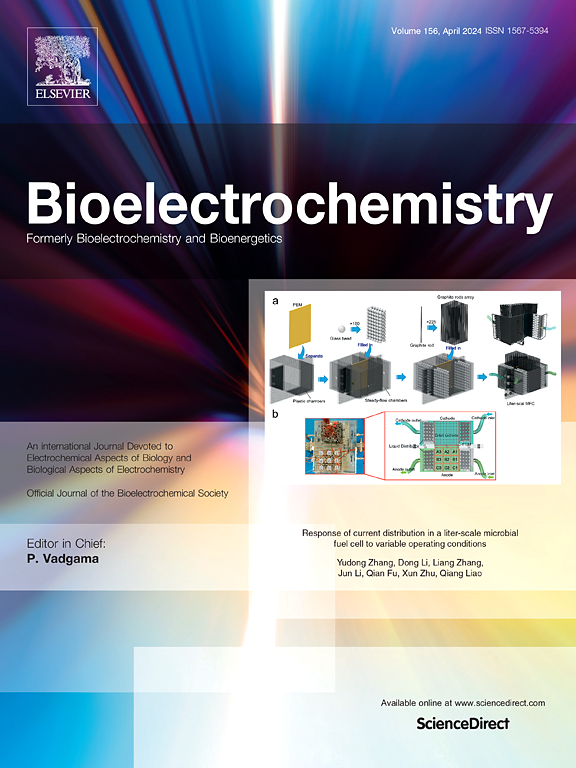核黄素光解对304不锈钢腐蚀的微生物影响
IF 4.8
2区 化学
Q1 BIOCHEMISTRY & MOLECULAR BIOLOGY
引用次数: 0
摘要
研究了核黄素对由古红假单胞菌TIE-1引起的304不锈钢微生物影响腐蚀(MIC)的影响。核黄素加速了MIC过程,加深和扩大了腐蚀坑。电化学结果表明,当核黄素添加量为40 ppm时,腐蚀速率显著提高。x射线光电子能谱(XPS)分析表明,钝化膜经历了由Fe2O3/Fe3O4/Cr2O3到FeOOH/Cr(OH)3的转变过程,并伴有核黄素促进的细胞外电子摄取(EEU)介导的Cr2O3氧化转化为CrO3。高效液相色谱(HPLC)结果证实核黄素降解为光色,加速细胞外电子转移(EET)。扫描电化学显微镜(SECM)分析表明,lumchrorome的氧化还原循环增强了EEU的效率,导致钝化膜的降解。本文章由计算机程序翻译,如有差异,请以英文原文为准。
Acceleration of microbiologically influenced corrosion of 304 stainless steel caused by photolysis of riboflavin
This study investigates the effect of riboflavin on microbiologically influenced corrosion (MIC) of 304 stainless steel induced by Rhodopseudomonas palustris TIE-1. Riboflavin accelerated the MIC process, deepening and expanding corrosion pits. Electrochemical results showed a significant increase in corrosion rate, especially with the addition of 40 ppm riboflavin. X-ray photoelectron spectroscopy (XPS) analysis demonstrated that the passive film underwent a compositional transformation from Fe2O3/Fe3O4/Cr2O3 to FeOOH/Cr(OH)3, accompanied by oxidative conversion of Cr2O3 to CrO3 mediated by riboflavin-facilitated extracellular electron uptake (EEU). High performance liquid chromatography (HPLC) results confirmed riboflavin degradation into lumichrome, which accelerated extracellular electron transfer (EET). Scanning electrochemical microscopy (SECM) analysis demonstrated that lumichrome's redox cycling enhanced EEU efficacy, resulting in the degradation of passive film.
求助全文
通过发布文献求助,成功后即可免费获取论文全文。
去求助
来源期刊

Bioelectrochemistry
生物-电化学
CiteScore
9.10
自引率
6.00%
发文量
238
审稿时长
38 days
期刊介绍:
An International Journal Devoted to Electrochemical Aspects of Biology and Biological Aspects of Electrochemistry
Bioelectrochemistry is an international journal devoted to electrochemical principles in biology and biological aspects of electrochemistry. It publishes experimental and theoretical papers dealing with the electrochemical aspects of:
• Electrified interfaces (electric double layers, adsorption, electron transfer, protein electrochemistry, basic principles of biosensors, biosensor interfaces and bio-nanosensor design and construction.
• Electric and magnetic field effects (field-dependent processes, field interactions with molecules, intramolecular field effects, sensory systems for electric and magnetic fields, molecular and cellular mechanisms)
• Bioenergetics and signal transduction (energy conversion, photosynthetic and visual membranes)
• Biomembranes and model membranes (thermodynamics and mechanics, membrane transport, electroporation, fusion and insertion)
• Electrochemical applications in medicine and biotechnology (drug delivery and gene transfer to cells and tissues, iontophoresis, skin electroporation, injury and repair).
• Organization and use of arrays in-vitro and in-vivo, including as part of feedback control.
• Electrochemical interrogation of biofilms as generated by microorganisms and tissue reaction associated with medical implants.
 求助内容:
求助内容: 应助结果提醒方式:
应助结果提醒方式:


